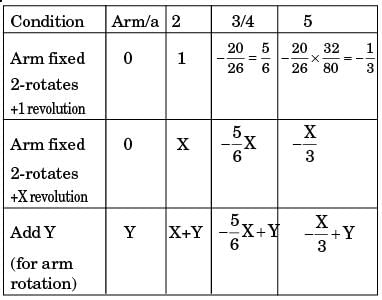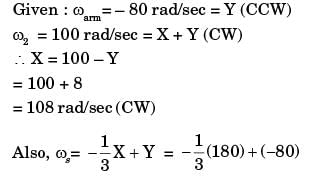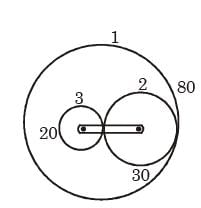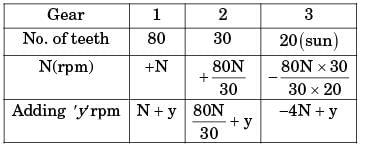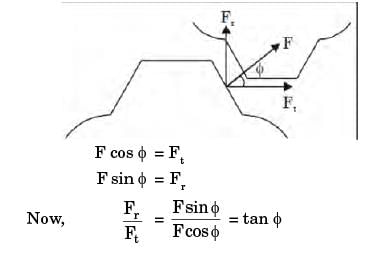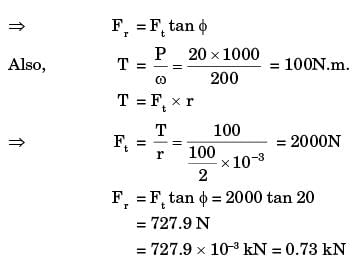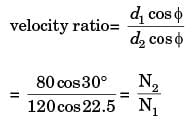GATE Past Year Questions: Gears & Gear Trains | Theory of Machines (TOM) - Mechanical Engineering PDF Download
Q1: The Levai type-A train illustrated in the figure has gears with module m = 8 mm/ tooth. Gears 2 and 3 have 19 and 24 teeth respectively. Gear 2 is fixed and internal gear 4 rotates at 20rev/min counter-clockwise. The magnitude of angular velocity of the arm is ______ rev/min. (rounded off to 2 decimal places) [GATE ME 2024]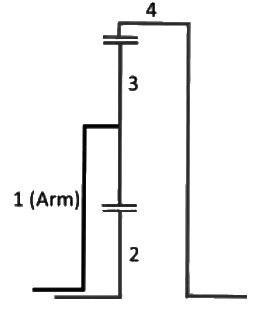
Ans: 15 to 16 [2016,Set-1]
Data given
m8 mm
T2 = 19
T3 = 24
N2 = 0
N4 = 20 rpm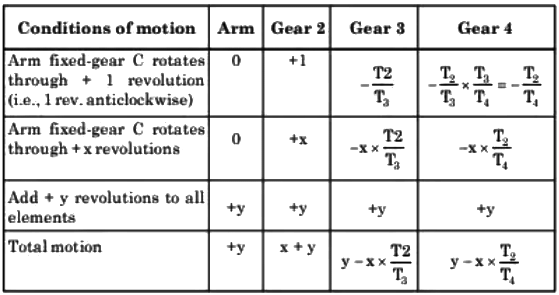 r4 = r2 + 2r3
r4 = r2 + 2r3
or, T4 = T2 × 2 T3
i.e.,
T4 = 19 + 2 × 24 = 67
As N2 = 0 So,
x + y = 0 ...(1)
N4 = 20 = y−x × (19/67)
or, y − x × (19/67) = 20 ... (2) By (i) and (ii)
k = -15.58 rpm
= 15.58 clockwise
y = 15.58 counterclockwise
Q1: Two meshing spur gears 1 and 2 with diametral pitch of 8 teeth per mm and an angular velocity ratio ∣ω2∣/∣ω1∣ = 1/4, have their centers 30 mm apart. The number of teeth on the driver (gear 1) is _______ . (Answer in integer) [GATE ME 2023]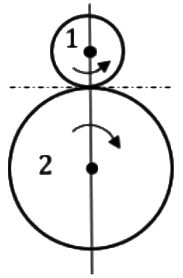 Ans: 95.999 to 96.001
Ans: 95.999 to 96.001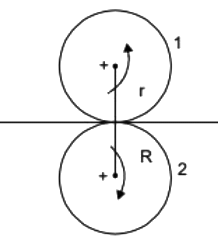 Given
Given
R + r = 30 ...(i) where T = no. of teeth
where T = no. of teeth
or T2 = 4T1
Diametrical pitch = 8 teeth/mm = T/D = Pd
and m = D/T = 1/Pd
r = mT/2
As, 
by equation (i) we have
As T2 = 4T1
So, 1/16 (T1 + 4T1) = 30
or σ1 = (30×16)/5 = 96
Q1: A schematic of an epicyclic gear train is shown in the figure. The sun (gear 1) and planet (gear 2) are external, and the ring gear (gear 3) is internal. Gear 1, gear 3 and arm OP are pivoted to the ground at O. Gear 2 is carried on the arm OP via the pivot joint at P, and is in mesh with the other two gears. Gear 2 has 20 teeth and gear 3 has 80 teeth. If gear 1 is kept fixed at 0 rpm and gear 3 rotates at 900 rpm counter clockwise (ccw), the magnitude of angular velocity of arm OP is __________rpm (in integer). [GATE ME 2022 SET-1] Ans: 600 to 600
Ans: 600 to 600
Speed of gear 1 N1 = 0,
Speed of gear 3 N3 = 900 rpm,
Speed of Arm Narm = ?,
Teeth of gear 1 z1 = ?
Teeth of gear 2 z2 = 20
Teeth of gear 3 z3 = 80
Teeth of gear 2
z3 = z1 + 2z2
80 = z1 + 2(20)
z1 = 40z N1 = x + y = 0
N1 = x + y = 0
⇒ x = -y
N3 = 
= y - (40/80)(x) = 900
⇒ y - (40/80)(-y) = 900
1.5y = 900
= 600 rpm
Q1: A power transmission mechanism consists of a belt drive and a gear train as shown in the figure. Diameters of pulleys of belt drive and number of teeth (T) on the gears 2 to 7 are indicated in the figure. The speed and direction of rotation of gear 7, respectively, are [GATE ME 2021 SET-2]
Diameters of pulleys of belt drive and number of teeth (T) on the gears 2 to 7 are indicated in the figure. The speed and direction of rotation of gear 7, respectively, are [GATE ME 2021 SET-2]
(a) 255.68 rpm; clockwise
(b) 255.68 rpm; anticlockwise
(c) 575.28 rpm; clockwise
(d) 575.28 rpm; anticlockwise
Ans: (a)
T3 = 44
T6 = 36
T2 = 18
T4 = 15
⇒ N1 = (150/250) x 2500
N1 = 15,00 = N2
= 255.6818 = N7 (Clockwise)
Gear 5 is idler.
Q1: The sun (S) and the planet (P) of an epicyclic gear train shown in the figure have identical number of teeth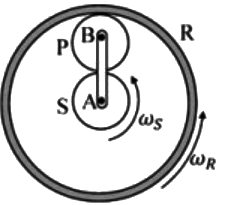 If the sun (S) and the outer ring (R) gears are rotated in the same direction with angular speed ωS and ωR, respectively, then the angular speed of the arm AB is [GATE ME 2020 SET-2]
If the sun (S) and the outer ring (R) gears are rotated in the same direction with angular speed ωS and ωR, respectively, then the angular speed of the arm AB is [GATE ME 2020 SET-2]
(a) 
(b) 
(c) 
(d) 
Ans: (a)
rs + 2rp = rR
⇒ Ts + 2Tp = TR (TP = TS)
3TP = TR
⇒ 3TP = TR y + x = ωS
y + x = ωS
y − (x/3) = ωR
Substract by,
4x/3 = (ωS - ωR)
x = 3/4 (ωS - ωR)
y = ωS - x = ωS - (3/4)(ωS - ωR)
Q2: A balanced rigid disc mounted on a rigid rotor has four identical point masses, each of 10 grams, attached to four points on the 100 mm radius circle shown in the figure.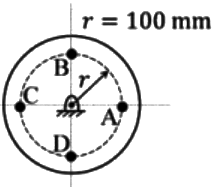 The rotor is driven by a motor at uniform angular speed of 10 rad/s. If one of the masses gets detached then the magnitude of the resultant unbalance force on the rotor is ______ N. (round off to 2 decimal places). [GATE ME 2020 SET-1]
The rotor is driven by a motor at uniform angular speed of 10 rad/s. If one of the masses gets detached then the magnitude of the resultant unbalance force on the rotor is ______ N. (round off to 2 decimal places). [GATE ME 2020 SET-1]
Ans: 0.09 to 0.11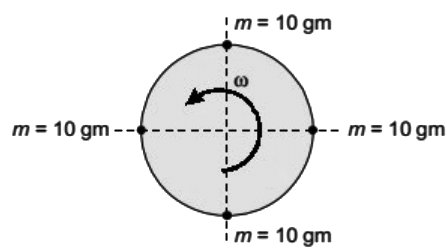 ω = 10rad/s, r = 100mm = 0.1m
ω = 10rad/s, r = 100mm = 0.1m
If one mass is detached then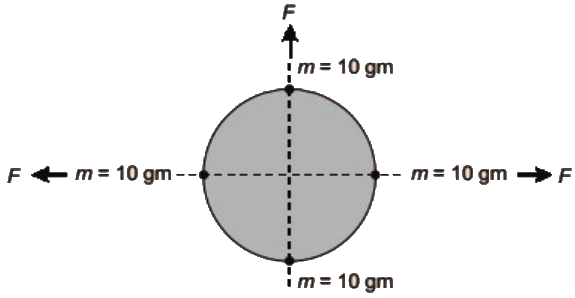 Now, unbalance tone, F = mrω2
Now, unbalance tone, F = mrω2
= (10/1000) x 0.1 x (10)2 = (10×0.1×100)/1000
= 0.1 N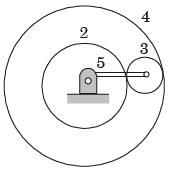
[2015,Set-3]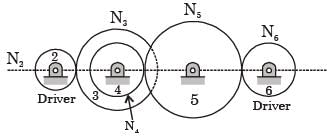
[2015,Set-2]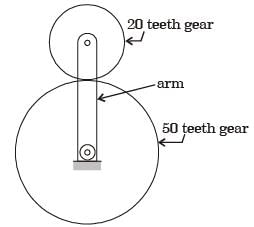
[2014,Set-3]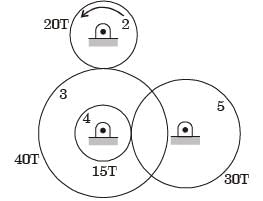
[2013]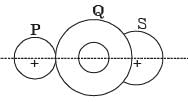
[2010]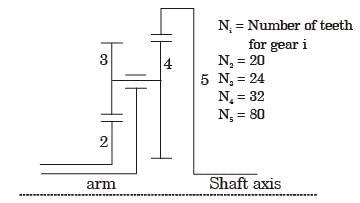
The arm 4 attached to the output shaft will rotate at [2009]
[1995]
[1993]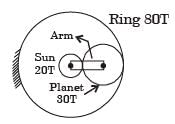
[2019,Set 2]
[2019, Set 1]
[2014,Set-4]
If the input speed is 1440 rpm, the output speed in rpm is [2012]
Gear I : Pitch circle diameter in the plane of rotation 80 mm and helix angle 30°
Gear II : Pitch circle diameter in the plane of rotation 120 mm and helix angle 22.5°
[2010]
[2000]
|
87 videos|76 docs|29 tests
|
FAQs on GATE Past Year Questions: Gears & Gear Trains - Theory of Machines (TOM) - Mechanical Engineering
| 1. What are the basic types of gears used in mechanical systems? |  |
| 2. How do gear ratios affect the performance of a gear train? |  |
| 3. What are the main advantages of using gear trains in machinery? |  |
| 4. What factors should be considered when designing a gear train? |  |
| 5. How can wear and tear be minimized in gear systems? |  |





